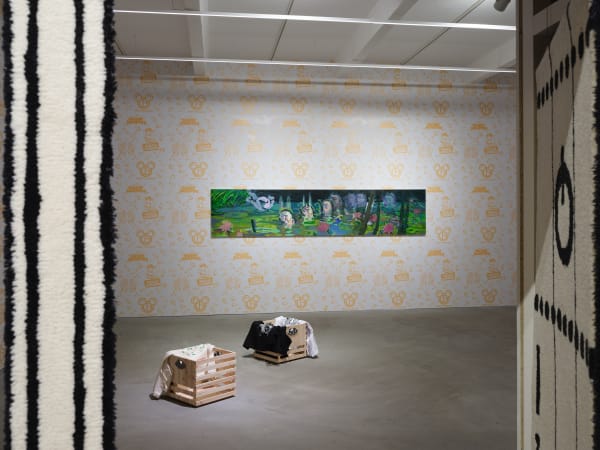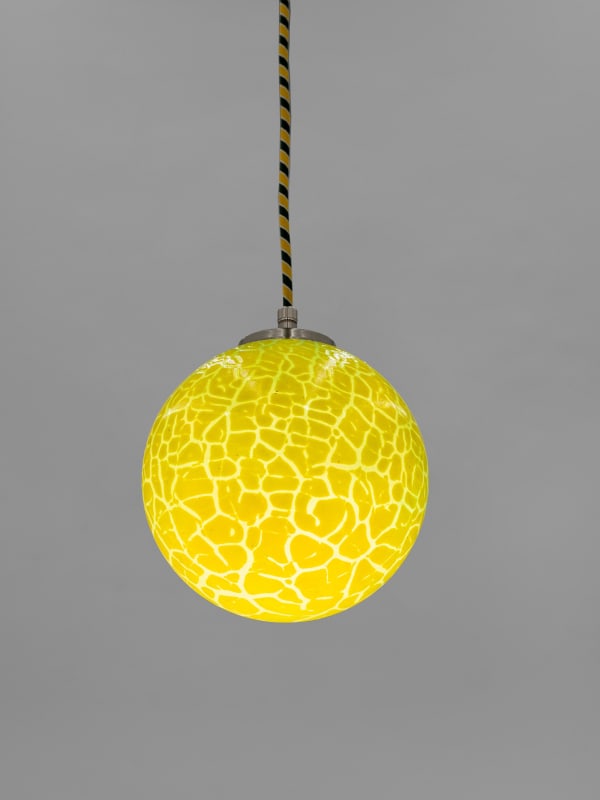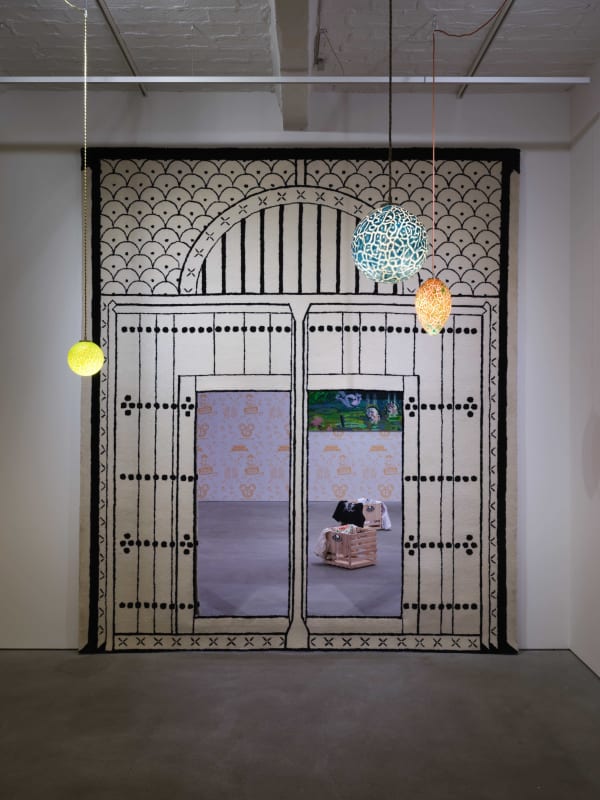HANG DON'T CUT : SLAVS AND TATARS feat. Andrey Anro, Dozie Kanu, Mina Masoumi, Lin May Saeed
-
 Hang Don't Cut, exhibition view, Kraupa-Tuskany Zeidler, Berlin, 2023
Hang Don't Cut, exhibition view, Kraupa-Tuskany Zeidler, Berlin, 2023 -
 Hang Don't Cut, exhibition view, Kraupa-Tuskany Zeidler, Berlin, 2023
Hang Don't Cut, exhibition view, Kraupa-Tuskany Zeidler, Berlin, 2023 -
 Hang Don't Cut, exhibition view, Kraupa-Tuskany Zeidler, Berlin, 2023
Hang Don't Cut, exhibition view, Kraupa-Tuskany Zeidler, Berlin, 2023 -
 Hang Don't Cut, exhibition view, Kraupa-Tuskany Zeidler, Berlin, 2023
Hang Don't Cut, exhibition view, Kraupa-Tuskany Zeidler, Berlin, 2023 -
 Hang Don't Cut, exhibition view, Kraupa-Tuskany Zeidler, Berlin, 2023
Hang Don't Cut, exhibition view, Kraupa-Tuskany Zeidler, Berlin, 2023 -
 Hang Don't Cut, exhibition view, Kraupa-Tuskany Zeidler, Berlin, 2023
Hang Don't Cut, exhibition view, Kraupa-Tuskany Zeidler, Berlin, 2023 -
 Hang Don't Cut, exhibition view, Kraupa-Tuskany Zeidler, Berlin, 2023
Hang Don't Cut, exhibition view, Kraupa-Tuskany Zeidler, Berlin, 2023 -
 Hang Don't Cut, exhibition view, Kraupa-Tuskany Zeidler, Berlin, 2023
Hang Don't Cut, exhibition view, Kraupa-Tuskany Zeidler, Berlin, 2023 -
 Hang Don't Cut, exhibition view, Kraupa-Tuskany Zeidler, Berlin, 2023
Hang Don't Cut, exhibition view, Kraupa-Tuskany Zeidler, Berlin, 2023
-
 Slavs and Tatars, Dark Yelblow, 2023
Slavs and Tatars, Dark Yelblow, 2023 -
 Slavs and Tatars, Dark Yelblow, 2023
Slavs and Tatars, Dark Yelblow, 2023 -
 Slavs and Tatars, Dark Yelblow, 2023
Slavs and Tatars, Dark Yelblow, 2023 -
 Slavs and Tatars, Dark Yelblow, 2023
Slavs and Tatars, Dark Yelblow, 2023 -
 Slavs and Tatars, Dark Yelblow, 2023
Slavs and Tatars, Dark Yelblow, 2023 -
 Slavs and Tatars, Dark Yelblow, 2023
Slavs and Tatars, Dark Yelblow, 2023 -
 Slavs and Tatars, Dark Yelblow, 2023
Slavs and Tatars, Dark Yelblow, 2023 -
 Slavs and Tatars, Dark Yelblow, 2023
Slavs and Tatars, Dark Yelblow, 2023 -
 Slavs and Tatars, Dark Yelblow, 2023
Slavs and Tatars, Dark Yelblow, 2023 -
 Slavs and Tatars, Dark Yelblow, 2023
Slavs and Tatars, Dark Yelblow, 2023 -
 Slavs and Tatars, Dark Yelblow, 2023
Slavs and Tatars, Dark Yelblow, 2023 -
 Slavs and Tatars, Dark Yelblow, 2023
Slavs and Tatars, Dark Yelblow, 2023 -
 Slavs and Tatars, Dark Yelblow, 2023
Slavs and Tatars, Dark Yelblow, 2023 -
 Slavs and Tatars, Dark Yelblow, 2023
Slavs and Tatars, Dark Yelblow, 2023 -
 Slavs and Tatars, Dark Yelblow, 2023
Slavs and Tatars, Dark Yelblow, 2023 -
 Slavs and Tatars, Dark Yelblow, 2023
Slavs and Tatars, Dark Yelblow, 2023 -
 Slavs and Tatars, Dark Yelblow, 2023
Slavs and Tatars, Dark Yelblow, 2023 -
 Slavs and Tatars, Dark Yelblow, 2023
Slavs and Tatars, Dark Yelblow, 2023 -
 Slavs and Tatars, Dark Yelblow, 2023
Slavs and Tatars, Dark Yelblow, 2023 -
 Slavs and Tatars, Dark Yelblow, 2023
Slavs and Tatars, Dark Yelblow, 2023 -
 Slavs and Tatars, Untitled (Fапча), 2023
Slavs and Tatars, Untitled (Fапча), 2023 -
 Slavs and Tatars, Untitled (Fапча), 2023
Slavs and Tatars, Untitled (Fапча), 2023 -
 Slavs and Tatars, Untitled (Qaptcha), 2023
Slavs and Tatars, Untitled (Qaptcha), 2023 -
 Slavs and Tatars, Untitled (Qaptcha), 2023
Slavs and Tatars, Untitled (Qaptcha), 2023 -
 Slavs and Tatars, Untitled (Gaptcha), 2023
Slavs and Tatars, Untitled (Gaptcha), 2023 -
 Slavs and Tatars, Untitled (Kапча), 2023
Slavs and Tatars, Untitled (Kапча), 2023 -
 Slavs and Tatars, Untitled (Gaptcha), 2023
Slavs and Tatars, Untitled (Gaptcha), 2023 -
 Slavs and Tatars, Untitled (Fапча), 2023
Slavs and Tatars, Untitled (Fапча), 2023 -
 Slavs and Tatars, Untitled (Kапча), 2023
Slavs and Tatars, Untitled (Kапча), 2023 -
 Slavs and Tatars, Untitled (Gaptcha), 2023
Slavs and Tatars, Untitled (Gaptcha), 2023 -
 Slavs and Tatars, Sanft Power, 2022
Slavs and Tatars, Sanft Power, 2022 -
 Andrey Anro, Vietnam Special Forces, 2022
Andrey Anro, Vietnam Special Forces, 2022 -
 Dozie Kanu, Knuckle crate (rejected Vitra design), 2022
Dozie Kanu, Knuckle crate (rejected Vitra design), 2022 -
 Dozie Kanu, Knuckle crate (rejected Vitra design), 2022
Dozie Kanu, Knuckle crate (rejected Vitra design), 2022 -
 Lin May Saeed, Barque, 2021
Lin May Saeed, Barque, 2021 -
 Lin May Saeed, Waterlandscape with Sea Dragons, 2021
Lin May Saeed, Waterlandscape with Sea Dragons, 2021 -
 Mina Masoumi, Lion lll, 2023
Mina Masoumi, Lion lll, 2023 -
 Mina Masoumi, untitled, 2022
Mina Masoumi, untitled, 2022
Uzbek legend has it that the melon originally grew only in the Garden of Eden. One day, the people received the melon as a divine gift from the Almighty, who had inscribed a message on it before sending it to them.The presence of tiny cracks on the ripe melon caught the attention of the locals, as they appeared to be reminiscent of Arabic script. The pattern is never repeated, so with each melon, the people were not only gifted a treat, but new knowledge. Unfortunately, the people could not decipher the melons’ message. Slavs and Tatars’ newest body of work looks to a variety of melons found in Central Asia, in particular in Uzbekistan and Xinjiang, as repositories of knowledge, as vectors of writing, as well as agencies of resource extraction. Considered to be a rare delicacy, the winter melon is carefully stored in warehouses (ковунхане) to ripen late, amongst the last fruit to do so as the first frosts arrive. So it is that the melon is coveted throughout Eurasia as an exceptional, almost miraculous product of nature: a luscious, sugary yield within an otherwise increasingly barren season and landscape.
Hang Don’t Cut, Slavs and Tatars' third exhibition at the gallery, presents a taxonomy of unique glass blown lamps (the Slavic etymology of melon stems from the verb дыть or "to blow”), each paying tribute to a particular species of Central Asian melon. Populating the gallery walls, mirror works feature a ‘captcha' camouflaged within the texture of a melon: a nod to the distinction between human and artificial intelligence while a new range of merch explores the discourse around melons, from cosmology to commerce.
Sanft Power (2022) a carpet doubling as doorway, serves as a threshold in the gallery space, inviting visitors to enter the second part of the exhibition, featuring a collection of works by Andrey Anro, Dozie Kanu, Mina Masoumi and Lin May Saeed, with whom Slavs and Tatars have collaborated with in the past. The showcased works further develop the concepts of writing, the universe and its complexity through different mediums such as paintings, sculpture, and installation, focusing on the aggression of state capture, whether it be towards natural resources or more intangible yet critical concepts such as integrity, souls, or opportunities.
SLAVS AND TATARS is an internationally renowned art collective devoted to an area East of the former Berlin Wall and West of the Great Wall of China known as Eurasia. Since its inception in 2006, the collective has shown a keen grasp of polemical issues in society, clearing new paths for contemporary discourse via a wholly idiosyncratic form of knowledge production: including popular culture, spiritual and esoteric traditions, oral histories, modern myths, as well as scholarly research.
The collective’s practice is based on three activities: exhibitions, publications, and lecture- performances. The collective has published more than twelve books to date, including most recently Лук Бук (Look Book) with Distanz Verlag. In 2020, Slavs and Tatars opened Pickle Bar, a slavic aperitivo bar-cum-project space a few doors down from their studio in the Moabit district of Berlin.
Recent solo exhibitions have taken place at CHAT, Hong Kong (2023); M HKA, Antwerp (2023); Humboldt Forum, Berlin (2022); Hacernoche, Oaxaca (2022); Neubauer Collegium Gallery, Chicago (2022); Cantor Fitz Gerald Gallery, Haverford (2021); Kunsthalle Osnabrück (2021); Hayward Gallery, London (2021); Pinakothek der Moderne, Munich (2021); Villa Arson, Nice (2020); Sugar Contemporary, Toronto (2019); Gallery «y», Minsk (2019); Kunstverein Hannover (2018); Albertinum, Dresden (2018); Westfälischer Kunstverein, Münster (2018).
ANDREY ANRO (b. 1987, Smarhon, Belarus) lives and works in Berlin. Anro uses painting, photography, digital collage, and installation to explore topics such as historical heritage, politics, dictatorship, religion, disappearance and death. The artist reappropriates historical imagery in the prism of mythology, as well as collective and historical memory, and visualises them through figurative painting. Anro’s works are in the collection of the Museum of Contemporary Art in Krakow (MOCAK), Poland, in the ART4 Museum in Moscow, in private collections in Lithuania, Sweden, Canada, Russia,and the USA. He has recently been exhibited at Sentiment, Zurich (2022); Gray Mandola Studio, Poznan (2021); KX space, Brest (2020); Third Place, Hrodna (2020, solo); Syntax gallery, Moscow (2019, solo), and National Center for Contemporary Arts, Minsk (2019).
DOZIE KANU (b. 1993, Houston, US) lives and works in Santarém, Portugal. Appropriating found objects and refashioning them to new aesthetics, Kanu creates sculptures and photographs that are inherently disobedient and stubbornly slippery. They resist classification and exist instead as communicative or performative objects. Kanu’s use of found, discarded objects honours and reanimates the people whose labour gave them function, and thus memorializes both the forsaken efforts and material casualties ofa culture’s emphasis on novelty and productivity. The artist’s ongoing investigation into the limits of form, functionality, materiality and usefulness are often filtered through a personal lens drawn from the artist’s lived experiences. Dozie Kanu’s first solo institutional exhibition was at the Studio Museum of Harlem in 2019. Recent exhibitions include Quinn Harrelson Gallery, Los Angeles (2023); Galerie Francesca Pia, Zurich (2022, solo); Neuer Essener Kunstverein, Essen (2022, solo); Project Native Informant, London (2022, solo); SFMoMA (2022); Public Art Fund, New York (2022), and Performance Space, New York (2021, solo).
MINA MASOUMI (b. 1985, Tehran, Iran) lives and works in Tehran. She is a graduate of Persian Literature from Zanjan University, and holds two Mumtaz-level excellence degrees in Nastaliq and Shekasteh- Nastaliq from the Society of Iranian Calligraphists. In her works, she derives inspiration from traditional Persian and Arabic schools and styles, illuminated manuscripts and classical Persian literature, Iranian and Islamic architecture, Persian Miniature and Middle-eastern culture. She is represented by Delgosha Gallery.
LIN MAY SAEED (b. 1973, Würzburg, Germany) lives and works in Berlin. Saeed makes sculptures, sculptural reliefs, drawings, works on paper and video. Known for her use of non-traditional materials, such as and especially styrofoam, Saeed’s work is directly linked to and thematically informed by her interest in animals and her commitment to animal activism. Her work deals with the exploitation of animals, their depiction, liberation, and potentially harmonious relationship with human beings, and the self-seeking meanness of the latter. Saeed’s iconographic frame of reference is rich and varied. It includes Egyptian statuary, Greco-Roman sculpture, and scientific and natural history museum displays. Saeed has recently exhibited at Chris Sharp Gallery, Los Angeles (2023, solo); Jacky Strenz, Frankfurt (2021, solo); Museo Castello di Rivoli, Turin (2021); IUCN World Conservation Congress, Marseille (2021); Museum of Contemporary Art Antwerp (2021); The Clark Art Institute, Williamstown (2020, solo); What Pipeline, Detroit (2019, solo). Upcoming exhibitions include Georg-Kolbe-Museum, Berlin (2023; solo) and Museum Frieder Burda, Baden-Baden (2023).















































